by Shashikanth Heerekar | May 26, 2025 | Uncategorized
Learn effective methods to align with AI algorithms and boost how easily your content gets found in modern search engines.
“Optimizing for AI visibility” means making your online content super easy for smart AI systems (like Google’s AI Overviews or ChatGPT, Perplexity, Gemini, etc.) to find, understand, and use in their answers.
It’s important now because more people get information directly from AI summaries, not just by clicking traditional website links. If your content isn’t “AI-friendly,” it might get missed in this new way of searching.
This AI chatbot provides summaries of the topics and also provides you with the relevant sites, which have disclosed each and every thing in the article.
Optimizing for AI chatbot visibility means in simple way, your content or information should be aimed to cited by artificial intelligence (AI) systems, mostly the search engines like chatgpt, Gemini, etc.
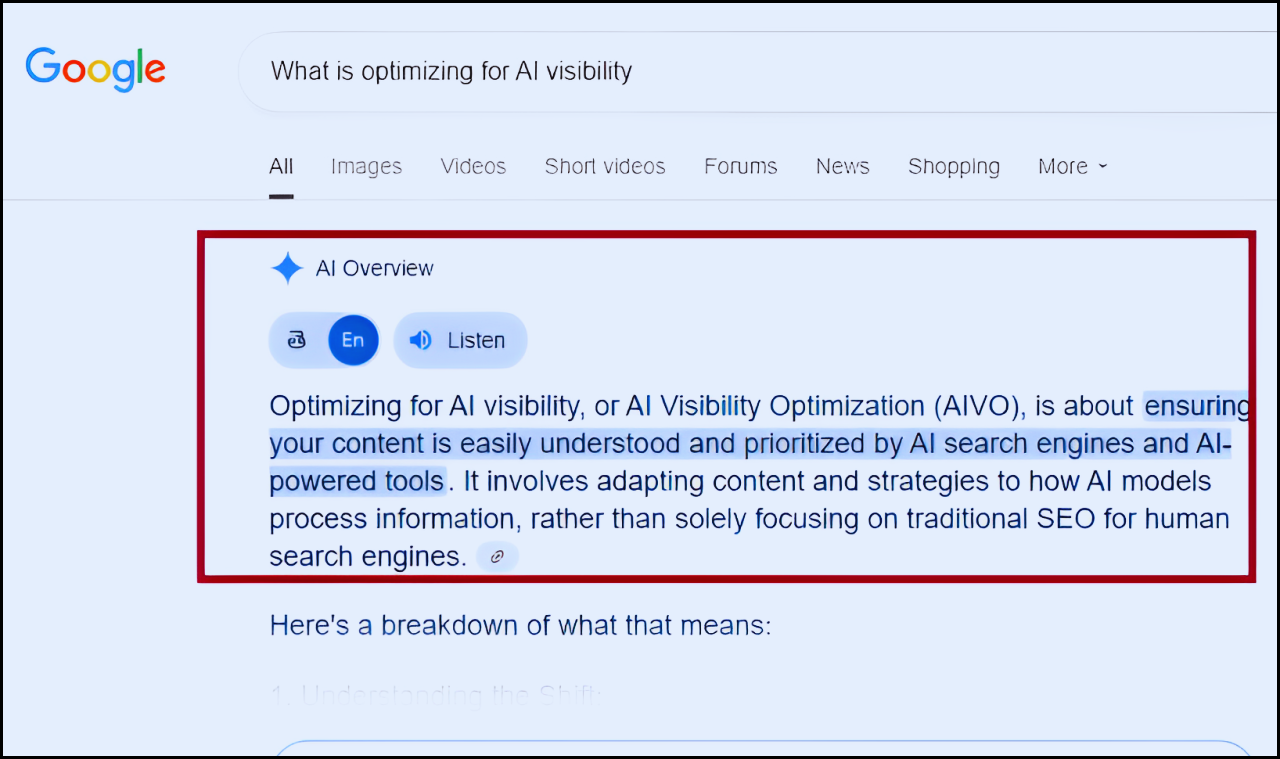
-
- Note: In the above image we can see Google AI Overview is integrated with Gemini.
In the above image you can notice how that AI overview is providing answers to the search query, whereas in the traditional way Google used to recommend us the website link for the search result, but now it has changed, so it is important for the content to be aimed at the Google chatbot.
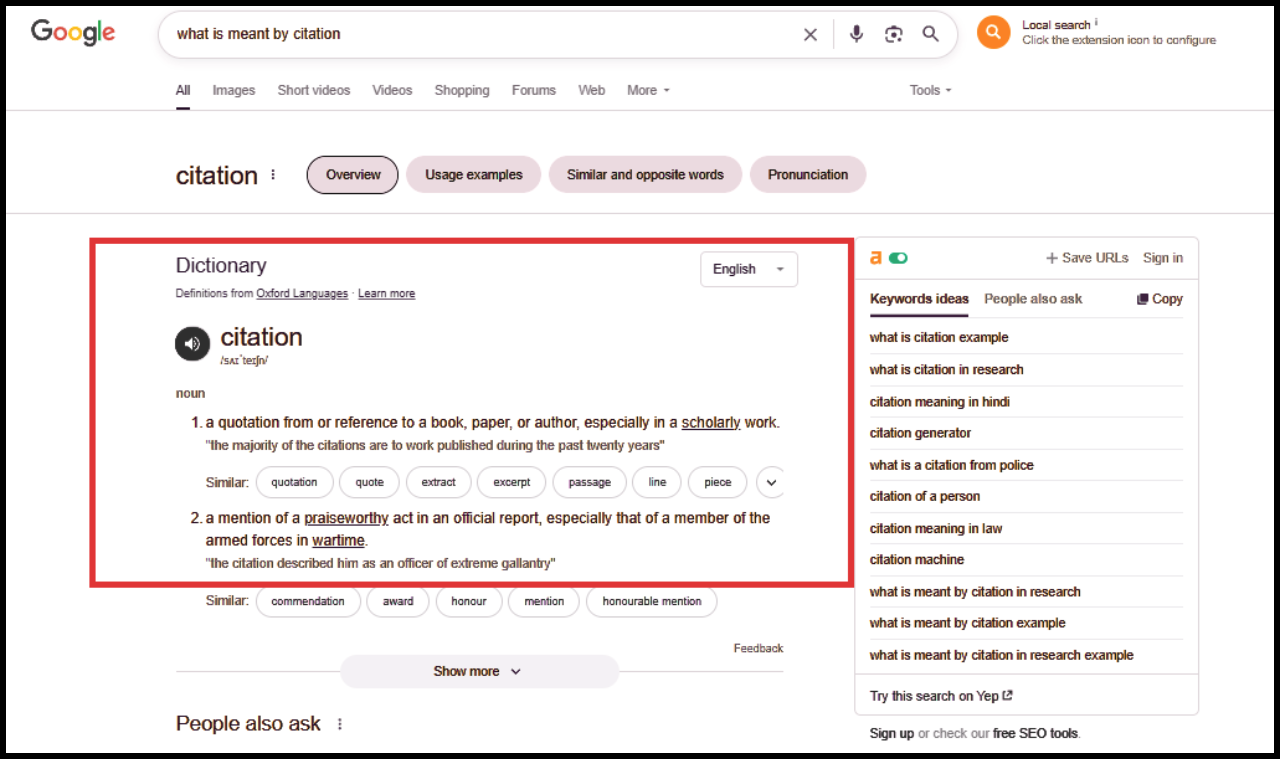
- Note: The above is the example of the traditional method. Where we can see there is not an AI overview.
Traditionally, websites used to have competition between them. Whoever’s content used to be informative or provide the latest updates, Google used to rank those website blogs at the top, but now Google is still doing the same but with little changes like providing AI overviews.
This AI chatbot will often summarize information from different websites and sometimes even telling you where it got that information and also redirect you to the website providing the latest and accurate information too.
Why AI Visibility Matters Now ?
In today’s digital landscape, AI visibility has become more critical and also more important than ever. With the rise of Generative AI Search and Search Generative Experience (SGE), content must also be crafted not just for the users but also for visible engines powered by AI (Gemini, ChatGPT, etc.)
Traditional SEO practices are now evolving and getting more advanced, as search engine optimization and AI SEO now prioritize context, relevance, and depth of content over mere keyword stuffing.
Understanding how to optimize for AI search is essential. Modern artificial intelligence engine optimization demands well-structured, insightful content that AI can interpret accurately. For example, a well-written blog with clear headings, rich context, and factual depth is more likely to appear in AI overviews generated by platforms like Google’s SGE (Search Generative Experience).
Now it is very crucial that your content be the latest and most accurate because more and more people will get answers directly from AI instead of clicking through many websites. If your information isn’t “AI-friendly,” you might get left out!
The Rise of AI Overviews and Generative AI Search
It is very important now to get listed in AI Overview because this AI chatbot is providing summarized answers to the query and providing the link to the website, so if the user is willing to learn more on that topic, they can directly click on that website. The below is the example of that topic.
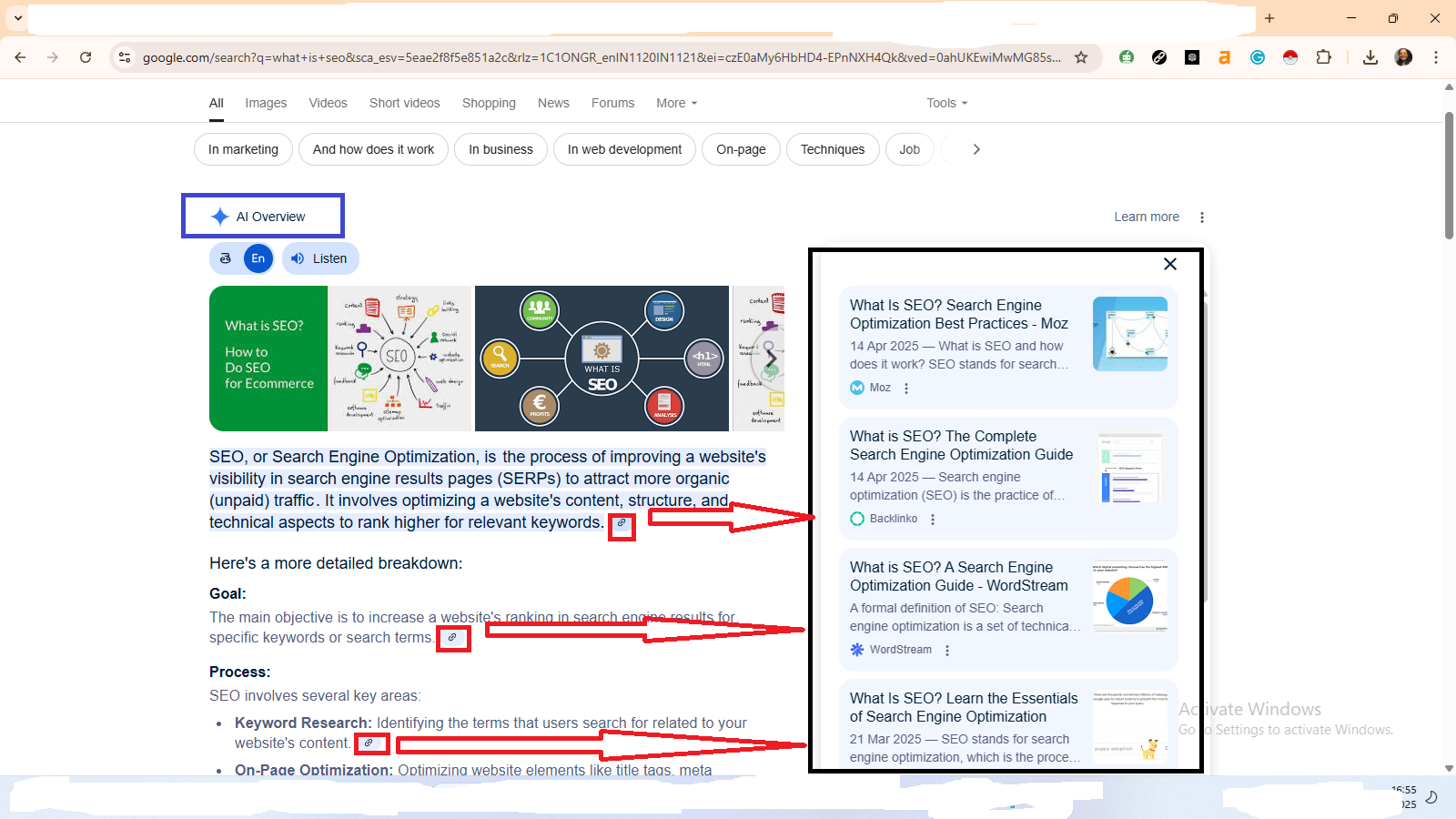
The Rise of AI Overviews and Generative AI Search marks a major shift in how users discover and interact with online content. Powered by Large Language Models (LLMs) and Natural Language Processing (NLP), Generative AI Search is changing traditional search behavior by delivering more human-like, summarized responses—known as AI Overviews.
With the evolution of AI Overviews and also generative AI search engines, they are reshaping the digital landscape, offering users more unlearned and comprehensive search experiences. You want the AI to pick your website as a reliable source when it creates these summaries. The advanced models, like Large Language Models (LLMs), Natural Language Processing (NLP), and Natural Language Understanding (NLU), are leading to significant shifts in user behavior and content strategies.
Okay, let’s break down that example in super simple terms:
Imagine you’re trying to find a good place to eat with your family in Goa, specifically an Indian restaurant.
The “Old Way” of Searching (Before AI Overviews):
You’d type “best Indian restaurants families Goa” into Google. Google would then give you a long list of website links. You’d have to click on each one, read through menus, check reviews, and see if it’s family-friendly. It’s like being handed a giant phone book and told to find a restaurant.
The “New Way” with AI Overviews (What’s Happening Now):
You type the same question. But now, instead of just a list of links, Google’s AI (its super-smart computer brain) might give you a short, easy-to-read answer right at the top.
This answer might say something like:
“For family-friendly Indian restaurants in Goa, consider:
- Spice Route: Known for its diverse menu and kid-friendly atmosphere in Candolim.
- North Goa: Offers authentic North and South Indian food with the perfect local Goa touch.
- Goa Spice: Offers authentic local dishes and a spacious seating area perfect for groups near Panaji.
- The Curry House: A popular choice for its delicious curries and welcoming staff in Baga”.
So, from the above example, you can understand how the AI overview is providing you a summary guide instead of visiting each website for your query.
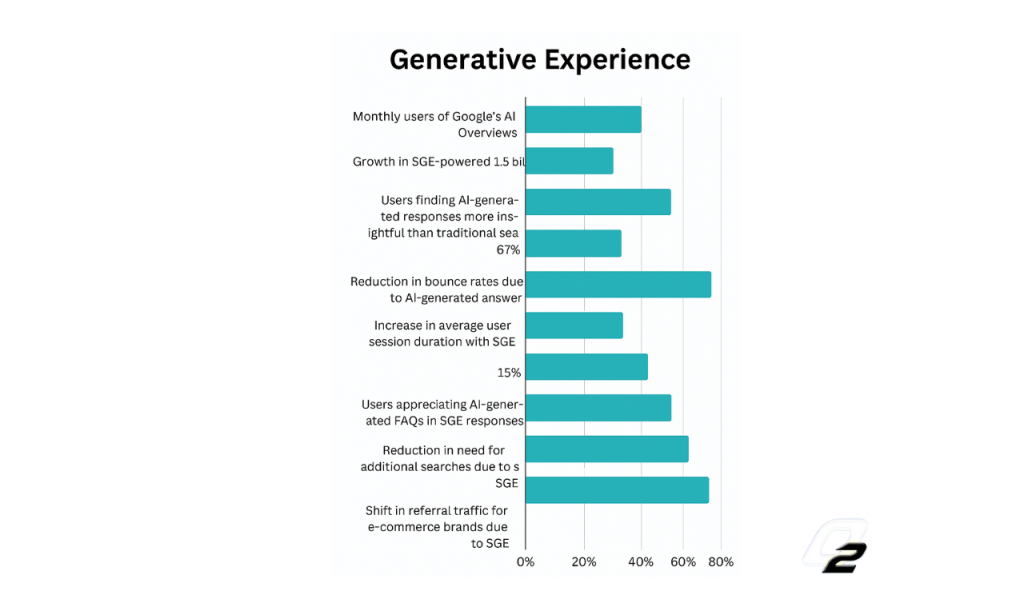
The above image shows how Google’s AI Overviews, powered by its Gemini AI platform, now serve over 1.5 billion users monthly, reflecting the increasing reliance on AI-generated search summaries—Source: Investopedia.
Growth in SGE-powered searches (QoQ) 35% – SEO Sandwitch
Users appreciating AI-generated FAQs in SGE responses 60% – SEO Sandwitch
Shift in referral traffic for e-commerce brands due to SGE 58% – Investopedia, SEO Sandwitch
How AI Models Process and Present Information
For developers or enthusiasts who want more control and privacy, it’s even possible to run ChatGPT locally, enabling them to use such AI capabilities without depending entirely on cloud services.
When you ask a question or type something in the feed, the AI uses something called Natural Language Processing (NLP). Think of this as the AI breaking down your words into tiny pieces and figuring out what each piece means.
Let’s assume you ask how to bake a cake with no eggs and milk. In the above query, you actually asked 3 questions for which this AI model will break down the entire sentence into single pieces and analyze each website answer and provide you with a summarized answer for your query in the AI overview, and it will also provide you with the external sources from where it gathered the information.
This is how this module works, it stores the information and later provides you with the summarized answer for you.
Here’s a simple example:
Let’s say you’ve got a long, detailed article—maybe 5,000 words—about a new type of electric car.
- Instead of you reading the whole thing, an AI like ChatGPT or Google’s Search Generative Experience (SGE) can quickly read it for you.
- It then summarizes that entire article into just a few short, easy-to-read bullet points. These bullet points will give you the main ideas and important facts without you having to spend a lot of time reading the original.
This way, AI saves you time and gives you direct, useful answers, making your online experience much smoother.
by Shashikanth Heerekar | May 16, 2025 | Uncategorized
Understand why choosing the right SEO company is crucial for downtown Houston real estate. Learn key factors to consider and what makes a top-tier SEO provider in this competitive market.
Introduction
In today’s digital-first property market, SEO for real estate in Houston is no longer optional—it’s essential. With more than 90% of homebuyers beginning their search online, visibility in search engine results pages (SERPS) is directly tied to success. In Downtown Houston, where real estate competition is intense and the market is fast-moving, having your business listed on Page 1 of Google is a strategic advantage.
Why Real Estate SEO is Crucial for Downtown Houston Agencies
In the hyper-competitive downtown Houston real estate world, simply listing properties and hoping for the best is no longer viable. To truly thrive and capture the attention of discerning buyers and sellers, a robust Real Estate SEO (Search Engine Optimisation) strategy is not just beneficial—it’s crucial for agencies operating in this dynamic market. Here’s why:
Significantly Boosts Organic Traffic to Your Property Listings and Blog:
Consider it: where do most people start searching for a new home or an agent to sell their property? The internet, and overwhelmingly, through search engines like Google. Effective SEO for Houston real estate ensures that when potential clients search for terms like “luxury condos downtown Houston,” “lofts for sale in the Houston Theater District,“ or even informational queries like “downtown Houston real estate market trends,“ your property listings and insightful blog content are prominently displayed in the organic search results. This means a consistent stream of highly qualified traffic to your website—users actively looking for what you offer.
Strategically Position Your Brand as a Market Leader in Houston Real Estate
Consistent, high-quality content that ranks well for relevant downtown Houston real estate keywords establishes your agency as a knowledgeable and authoritative voice in the local market. You build trust and credibility with potential clients by providing valuable information, expert advice, and showcasing your expertise in navigating the intricacies of Houston’s downtown property scene. This positions your brand as a go-to resource, making you the natural choice when they are ready to buy, sell, or rent.
Dramatically Improves Local Search Visibility (e.g., Appearing Prominently in Google Maps Results)
For real estate, local is everything. Buyers often search for properties and agents within specific neighbourhoods. Local SEO for Houston real estate ensures that your agency appears prominently in local search results, including the coveted Google Maps results. When someone searches for “real estate agent near me downtown Houston,“ you want your agency to be one of the first they see. This increased visibility makes it easier for local clients to find you, visit your office, or explore your listings.
Generates Consistent Inbound Leads Without Solely Relying on Expensive Paid Advertising
While paid advertising can quickly boost visibility, it requires continuous financial investment. Effective real estate SEO is a long-term strategy that builds a sustainable pipeline of inbound leads—potential clients who find you organically through their search queries. This reduces your reliance on costly ad campaigns and delivers a higher return on investment over time by attracting motivated leads actively seeking your services.
Understanding Real Estate SEO: Key Strategies for Success in the Houston Market
Unlike traditional SEO, which often casts a wide net with broader keywords, real estate SEO demands a laser focus, particularly within a localized and niche-specific market like Houston. Generic SEO tactics won’t cut it to effectively reach potential buyers and sellers in this sprawling metropolis. Real estate SEO in Houston thrives by targeting hyperlocal search terms—think specific neighbourhoods and communities—and understanding the distinct buyer intent keywords that signal a user’s position in the property journey.
Local Keyword Optimization: Pinpointing Your Houston Audience
The foundation of successful Houston real estate SEO lies in identifying and strategically using geo-targeted keywords. These phrases connect you directly with individuals searching for properties or real estate services in specific areas. Examples include:
- Downtown Houston condos for sale: Targeting those interested in urban living.
- Luxury apartments in Midtown Houston: Appealing to a specific rental market segment.
- Best real estate SEO company in Downtown Houston: If you’re targeting other real estate businesses.
- Consider also including terms like “[Neighbourhood Name] real estate agent,” “[Neighbourhood Name] open houses,“ or “[Neighbourhood Name] property management.”
On-Page SEO for Real Estate Websites: Optimising Your Digital Shopfront
Your website’s structure and content need to be finely tuned to attract both users and search engines:
Optimizing title tags and meta descriptions:
These are your website’s snippets in search results. Use compelling language and incorporate Houston-specific keywords to entice clicks (e.g., “Luxury Condos in Downtown Houston – See Listings Now!”).
- Structuring H1, H2, and H3 headings with relevant keywords: Use headings to organize your content logically and include keywords to help search engines understand the topic of each section. For example, an H2 could be “Benefits of Living in Downtown Houston.”
- Adding alt-text to property images: Describe your photos using relevant keywords (e.g., “Modern kitchen with stainless steel appliances in downtown Houston condo”). This helps search engines understand the visual content.
- Creating internal links between listings, blog posts, and service pages helps users navigate your site and distributes link equity, improving the visibility of important pages. For instance, you could link related property listings to blog posts about the neighborhood.
High-Quality Content Creation: Becoming Houston’s Real Estate Resource
Providing valuable, in-depth content establishes you as an expert and attracts organic traffic. Develop blog articles that cater to the needs and interests of your Houston audience, such as:
- “Best Townhomes in Downtown Houston Under $500K”: Targeting a specific budget and property type.
- “Why Houston is a Top Real Estate Investment Destination”: Attracting investors with market insights.
- Consider articles on neighbourhood guides, school district information, tips for first-time homebuyers in Houston, or market trend analyses specific to Houston areas.
Google Business Profile and Map Pack Optimisation: Dominating Local Houston Search
Your Google Business Profile (GBP) is crucial for showing up in local map results and attracting nearby clients. Real estate agencies in Houston must:
- Verify and update NAP (Name, Address, Phone): Ensure this information is accurate and consistent across all online platforms.
- Upload high-resolution photos: Showcase your office, team, and featured properties.
- Encourage client reviews with targeted keywords: Prompt satisfied Houston clients to leave reviews mentioning specific neighbourhoods or aspects of your service. (Stat: Online reviews act as powerful social proof; businesses with more positive and recent reviews often see a significant increase in click-through rates from local search results.)
Mobile and Speed Optimization: Delivering a Seamless Houston User Experience
In today’s mobile-first world, a fast, mobile-optimized website is non-negotiable, especially for Houston real estate, where many searches happen on the go. Real estate users expect:
- High performance: Pages load quickly, especially when browsing numerous property listings. (Stat: Studies show that a delay of just one second in page load time can decrease conversion rates by up to 7%.)
- Quick-loading pages: Optimise images and website code to ensure fast loading times on all devices.
- Mobile-friendly design: Ensure your website is responsive and easy to navigate on smartphones and tablets, with clear calls to action and easy-to-use search filters.
Evaluating SEO Companies: What to Look for in a Downtown Houston Firm
Choosing the right real estate SEO company in Houston can make or break your online strategy. Here’s how to vet a prospective firm:
Industry-Specific Experience
Does the agency specialize in real estate? Look for companies that have:
- Ranked IDX-enabled websites
- Generated organic traffic for realtors and brokers
- Delivered leads in competitive local markets like Houston
Knowledge of the Local Houston Market
Familiarity with neighbourhoods like Midtown, Eado, and the Heights is crucial. A top-tier firm will know:
- Local buyer personas
- Neighbourhood search trends
- School zone preferences and commute times
Transparent Reporting & Metrics
The best SEO companies provide detailed analytics reports including:
- Organic traffic growth
- Keyword position changes
- Bounce rate improvements
Customized SEO Strategy
Avoid cookie-cutter solutions. A great agency will develop:
- A content roadmap focused on Houston neighbourhoods
- A technical SEO checklist specific to your website structure
- A link-building strategy with local relevance
Top Benefits of Hiring a Specialized Real Estate SEO Company
Partnering with Downtown Houston’s best real estate SEO company offers several advantages.
Increased Search Visibility
Ranking higher for searches like “real estate agents Downtown Houston“ brings more relevant traffic and qualified leads.
Better Lead Conversion Rates
Optimized pages and user experience lead to longer site visits, more contact form submissions, and better conversion metrics.
Competitive Advantage in Local SERPS
With so many realtors operating in Houston, high-quality SEO separates your business.
More Referrals and Reputation Management
SEO agencies often assist with review management, ensuring your business stands out in Google, Yelp, and Zillow reviews.
Common SEO Challenges for Real Estate Businesses in Houston
Despite the benefits, there are several hurdles to effective real estate SEO in Houston.
High Competition in Downtown Houston
Downtown listings are premium, meaning competition for SEO keywords like “Downtown Houston real estate agent“ is fierce. Standing out requires a highly strategic approach.
Frequent MLS Data Updates
Maintaining SEO integrity across a dynamic website can be challenging with constantly changing listings.
Duplicate Content Risks
If multiple real estate agents use the same property descriptions or MLS data, duplicate content can create issues that hurt rankings.
Lack of In-House SEO Expertise
Many agencies don’t have full-time SEO staff, making it difficult to stay consistent and strategic without outside help.
Case Studies: Success Stories from Houston’s Leading Real Estate SEO Companies
Case Study 1: Midtown Realtor Increases Organic Traffic by 325%
A solo agent specializing in Midtown hired a local SEO agency that:
- Created weekly blog posts targeting “Midtown Houston condos”
- Built citations on real estate directories and Houston blogs
- Optimized Google Business Profile with 5-star reviews
Result: 325% increase in organic traffic and 3x more qualified leads.
Case Study 2: Eado Brokerage Dominates Google Maps Pack
A boutique brokerage struggled to get listed in the Google 3-Pack. The SEO company:
- Verified and optimized GBP
- Added location-rich service pages
- Launched a review generation campaign
Result: 1st page ranking for “Eado real estate agents“ and a 40% increase in calls from Maps.
Conclusion
When looking for the best real estate SEO company in Downtown Houston, prioritize:
- Local market knowledge
- Proven SEO results
- Custom strategy development
- Transparency and communication
A reliable partner will align your SEO strategy with Houston’s unique housing trends, helping you rise above competitors, generate more leads, and establish long-term dominance in SERPS.
Faq’s
1. What is real estate SEO, and how does it help my Houston agency?
Real estate SEO is the process of optimising your website and content to rank higher on search engines like Google. For agencies in Downtown Houston, it helps attract more qualified local leads by improving visibility for searches like “Downtown Houston condos“ or “best realtor in Houston.”
2. How long does it take to see SEO results for a real estate website?
SEO is a long-term strategy. Typically, you’ll start seeing improvements within 3 to 6 months, but significant results like top-page rankings in Houston may take 6 to 12 months, depending on competition and your website’s current state.
3. Why should I hire a specialised real estate SEO company in Downtown Houston?
A local, specialised SEO company understands Houston’s housing market, neighbourhoods, buyer behaviour, and competitive keywords. This local expertise helps generate faster, more targeted results compared to generic SEO services.
4. What keywords should my real estate business target?
Focus on a mix of geo-targeted and long-tail keywords like: \ n- Downtown Houston real estate agents- Luxury apartments in Midtown Houston- Buy townhomes in Eado Houston- Houston real estate SEO experts.
5. How much does real estate SEO cost in Houston?
Costs vary based on the scope and competition. On average, monthly SEO services in Houston range from $750 to $3,000+. High-quality agencies provide detailed reports, strategic planning, and ROI tracking to justify the investment.

by Shashikanth Heerekar | May 7, 2025 | All Things about Marketing, SEO News, Tutorial and Case Studies, Uncategorized
–Unlock real-world strategies to help you rise above competitors and attract more clicks through better search placement.
What is search engine positioning?
Imagine you’ve written a brilliant article and published it on your website. But what good is that article if it’s hidden on the 15th position of Google’s search results? That’s where search engine positioning comes into play. It refers to your webpage’s exact placement in search engine outcome pages (SERPS) for a specific keyword.
Unlike general SEO, which encompasses the entire strategy to improve visibility, positioning focuses purely on where a page lands. Let’s say your webpage is ranking #4 for “eco-friendly gardening tools.” Your aim isn’t just to remain in that position but to climb to the top three, or even number one. That upward movement—that specific target—is your positioning goal.
Search engine positioning versus SEO
While both serve the same overarching aim—visibility—they approach it from different angles. SEO (Search Engine Optimisation) is a broad umbrella that includes technical SEO, on-page optimisation, backlinks, content creation, mobile responsiveness, and page speed.
Search engine positioning drills down into ranking refinement. It answers questions like:
- Which of my pages ranks where?
- For which keywords?
- How can I move Page X from position 8 to position 3?
SEO builds the roads, positioning directs the traffic.
Let’s look at an example of what a positioning strategy might try to accomplish:
Imagine you have a blog post titled “The Best Organic Skincare for Summer.” It ranks 9th on Google for the keyword “organic summer skincare.”
A positioning strategy might include:
- Updating the blog with new statistics and trends for 2025
- Enhancing keyword usage in headers and alt text
- Adding internal links from top-performing skincare blogs
- Resharing it on social media with a new visual
These steps aim to nudge that blog closer to the coveted top three slots.
Note : In the below given image blogs ranks on top of searches only because of updated or revised content, search engine works and crawl everyday.
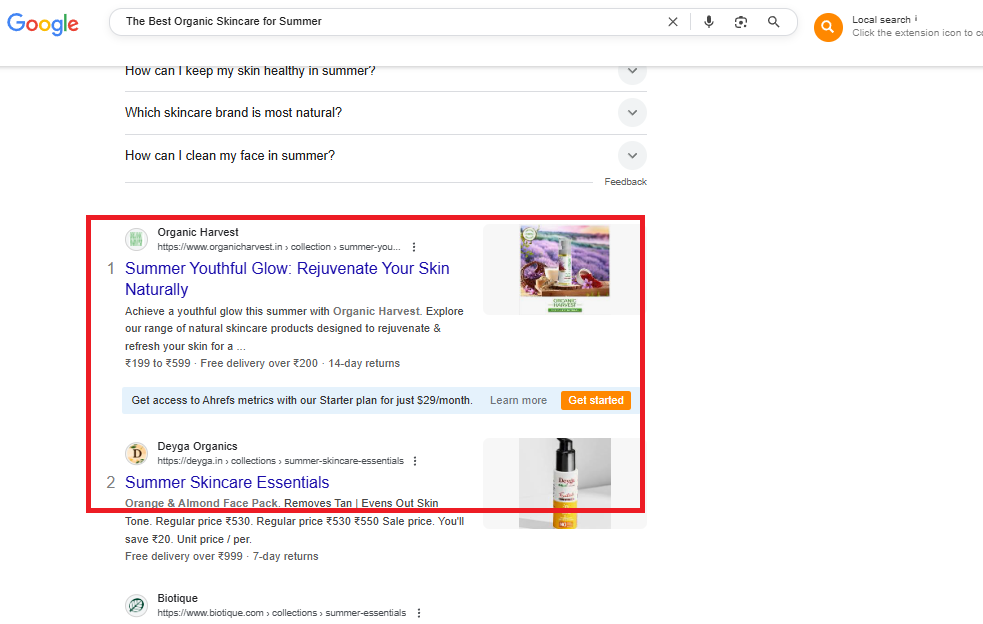
How does a search engine determine a page’s position?
Google and other engines use a multitude of signals to rank content:
- Relevance to the search query (keywords in titles, meta, body text)
- Authority (backlinks from credible domains)
- Freshness (how recently it was published or updated)
- User experience (bounce rate, dwell time, site speed)
Each element contributes to your page’s positioning score, an invisible metric determining its SERP placement.
Note : The below image is an example for my above context

Every factor – relevance, authority, freshness – plays a role in where a page lands in the results. One proven way to influence that is through high-quality, niche-relevant backlinks pointing to your most important BOFU pages. Agencies like linkbuilding.company specialise in this, often using multiple guest posts on the same topic across hyper-relevant sites to “hack” the SERPs for best “product” keywords. This approach doesn’t just move rankings – it can also push your content into AI search results from tools like ChatGPT and Perplexity, giving your brand visibility with buyers before they even open a browser. When you own those BOFU positions, the impact on leads, sales, and ROI is immediate.
Why is search engine positioning important?
The digital realm is a battleground. Thousands of pages may be competing for the same keyword. But only the top few see meaningful traffic. According to recent data, the first three results on Google capture over 60% of clicks.
If your page is ranking 6th or lower, you’re practically invisible.
Strong search engine positioning means:
- Higher visibility
- Increased organic traffic
- Greater brand trust and authority
- More conversions without paying for ads
Positioning is the silent salesman of your content strategy—quietly pushing your message to the front of the line.
Is their any possiblities to improve your search engine positioning?
There’s no silver bullet, but there are targeted techniques that can significantly improve your SERP positioning.
Tip No. 1: Update the content in question and reshare it on social media
Updating your content’s performance is one of the most effective ways to revive it. Search engines promote content that appears fresh and regularly maintained. Even small changes—like correcting outdated facts, refreshing statistics, or adjusting the year—can improve its relevance and visibility. For example, if you had a post titled “Digital Marketing Trends in 2023,” to which you have updated it to “Digital Marketing Trends in 2025” with recent data and insights can significantly boost its SEO performance.
These latest changes in the post alert search engines that the content is latest, unique and trustworthy, which can help improve rankings and increase organic traffic from users seeking the latest information.
Note : The below is the example of above said phrases.
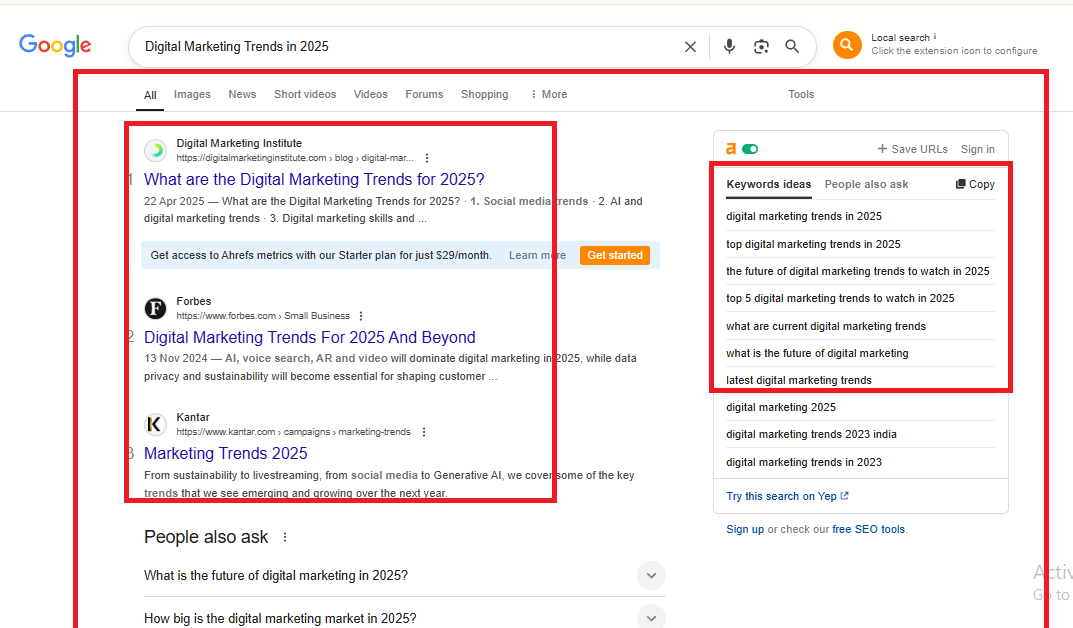
Besides updating factual details, check for outdated visuals and links that may no longer function or appear relevant. Substituting old screen grabs to new, adding new internal linking, and or else including new sections or FAQS can drastically enhance the user experience.
For example, if your snap included a screenshot of an old snap interface, replacing it with a 2025 version showing the latest feature, like in-app shopping insights, can make your content feel more relevant and polished. Additionally, adding a new section, “How Instagram’s AI tools are changing content engagement”, will align your article with evolving user interests and search trends.
Once your content is updated, reshare it across your social channels to attract new attention. Don’t just post the same caption—introduce the content with a fresh hook, headline, or teaser highlighting what’s new. For example, if your article now includes updates about LinkedIn’s 2025 content algorithm changes, your post could say: “New Update: Learn how LinkedIn’s algorithm shift is changing B2B marketing this year!”
Pair this with a relevant image—either a new screenshot of the LinkedIn dashboard or a custom graphic summarising the changes. You can use a free screenshot editor to annotate, crop, or enhance the image before sharing it.
You can create such visuals using tools like Visme and Canva or source professional stock images from sites like Unsplash or Pexels. Add alt text with descriptive keywords when uploading images to improve SEO and accessibility.
Note : Updated article will perform in best possibilites compare with old content, the below is the set of example which has personally happen to me.
After updating my artcile my keywords are suddenly got ranked within 24 hours of time.

Tip No. 2: Re-optimize meta tags and meta descriptions for top key phrases
In today’s content landscape, AI-powered writing tools are transforming how marketers refine their pages for search intent and readability. These tools not only assist in crafting well-structured, engaging content but also ensure it aligns with search algorithms’ evolving understanding of quality. Using an all-in-one AI writing assistant can help you humanize your tone, enhance meta descriptions, and make every update feel more natural to both readers and search engines.
Another powerful way to refresh old content and improve visibility is by re-optimizing your meta tags and meta descriptions using current top-performing keywords. Meta titles and descriptions are a summary for search engines and users, directly influencing click-through rates. Over time, keyword trends change, so revisiting these elements to ensure they align with how people search today is essential.
For example, if your article originally targeted “digital marketing techniques,” but data now shows “AI-driven digital marketing strategies” as a rising phrase, updating your meta title and description to reflect that change can boost your ranking and draw more qualified traffic.
When re-optimizing, focus on including the primary keyword at the beginning of the meta title while keeping the title within 60 characters. For the meta description, aim for a compelling summary of 150–160 characters that includes the main keyword and a clear value proposition.
For example, instead of a non-specific meta description like “Learn about digital marketing,” you might phrase “Explore top AI-driven digital marketing strategies for 2025 to boost ROI and stay ahead of trends.”
This enhances your overall Meaning of search engine optimisation performance and encourages users to click by aligning with their needs and search intent through updated, engaging language. After updating your meta tags, promote your refreshed content with a visual post or infographic to strengthen your search engine optimization strategy.
For example, create a side-by-side graphic showing the old and new meta descriptions, or an image summarising the updated keyword focus like “Now targeting: AI-driven marketing.” Use free tools like Canva to design a clean, branded image and choose icons or illustrations related to SEO or keyword research.
Add relevant alt text, such as “Updated SEO meta description example for 2025”, to help search engines understand the image context. Sharing this on social media can also educate your audience while boosting your content’s exposure.
Tip No. 3: Change and retify your internal linking strategy
Internal linking is a smart and scalable way to increase SEO strength. Interlinking is the best strategy to interlink your post that has low traffic or is not performing well on Google. To that article, you can interlink with an article that is performing very well on search engines. In this strategy, you can direct the readers to go to the order blog post, which also provides you with quality information.
Okay, imagine your website is like a library.
Internal linking is like putting signs inside the library pointing to other related books. Helping lower-ranked pages: If you have a popular book (high-ranking page), and you put a sign in it that says “For more information, check out this book on a similar topic” (linking to a lower-ranking page), it helps people (and search engines) discover that other book.
Easy for search engines: These signs also help the librarian (search engine) easily find and organize all the books in your library.
Better SEO: More signs pointing to relevant books make your whole library look more organized and helpful to the librarian.
A good internal linking strategy doesn’t mean stuffing links randomly—it should feel natural and provide added value to the reader. Use descriptive anchor text that tells users what they can expect by clicking. For instance, instead of “click here,” you can say, “check out our detailed guide on AI-powered email tools.”
Periodically review old blog posts and add links to your newer, high-performing content. This keeps your pages interconnected and up to date, which helps both users and search engines discover more of your content, improving crawlability and user engagement metrics like time on site.

Note : In the above image which clearly shows, how interlinking is going to work. Interlinking is nothing but a road map, for not only users but also to the search engines.
Tip No. 4: Add or change the page’s featured image
A compelling featured image can significantly attract clicks and shares, especially when promoting your content on social media or appearing in search previews. Using a good logo maker to incorporate consistent branding elements into the image can boost recognition and trust. Refreshing the featured image is a quick and visual way to signal new value in your content.
For example, if your original blog post on “Top SEO Tools” had a generic stock image from 2020, replacing it with a modern, eye-catching graphic showing logos of the latest tools in 2025, like Surfer SEO or NeuronWriter, can instantly boost user interest and credibility.
For example, you are having a cake bakery and the featured image is related to a shoe brand, uhh, this is not going to work right?
Avoid outdated visuals or overly generic images; aim for clean, branded designs or helpful infographics. Tools like Canva allow you to quickly design a new featured image incorporating bold text, icons, and brand colours.
When updating your image, remember to optimize it for search engines. Rename the image file with relevant keywords (e.g., “seo-tools-2025-featured.jpg”) and use alt text like “Top SEO tools of 2025: Its summary.” This helps with both accessibility and image-based search traffic. Re-uploading a new featured image allows for resharing the content across platforms with a fresh look.

Note : The above image is seriously a funny miskate, the caption is no were realted to image.
Uhh!!! Avoid this kind of mistakes. The image should be excatly related to the topic what you are delivering or what is your intent.
Tip No. 5: Try to use the new content proposal as needed
It is very crucial to understand that experiment with new content proposal when needed should be to the point and engaging. Audiences and algorithms evolve, and sticking to the same format may cause even valuable content to lose traction over time.
Trying different formats—like converting a text-heavy blog post into a listicle, infographic, video, or podcast transcript—can bring new life to the same topic. For example, if your post “Top LinkedIn Marketing Strategies” isn’t performing well, you might repackage it into a carousel-style visual post or a step-by-step video guide.
New content arrangement don’t just improve your ranking but it may open doors to broader SEO opportunities. Google unroll search results often favour diverse media formats like video snippets, FAQS, and how-to guides.
NOTE : The image shows how FAQ’S or PEOPLE ALSO ASK, is very much important in writing a blog post. REMEMBER !!!!
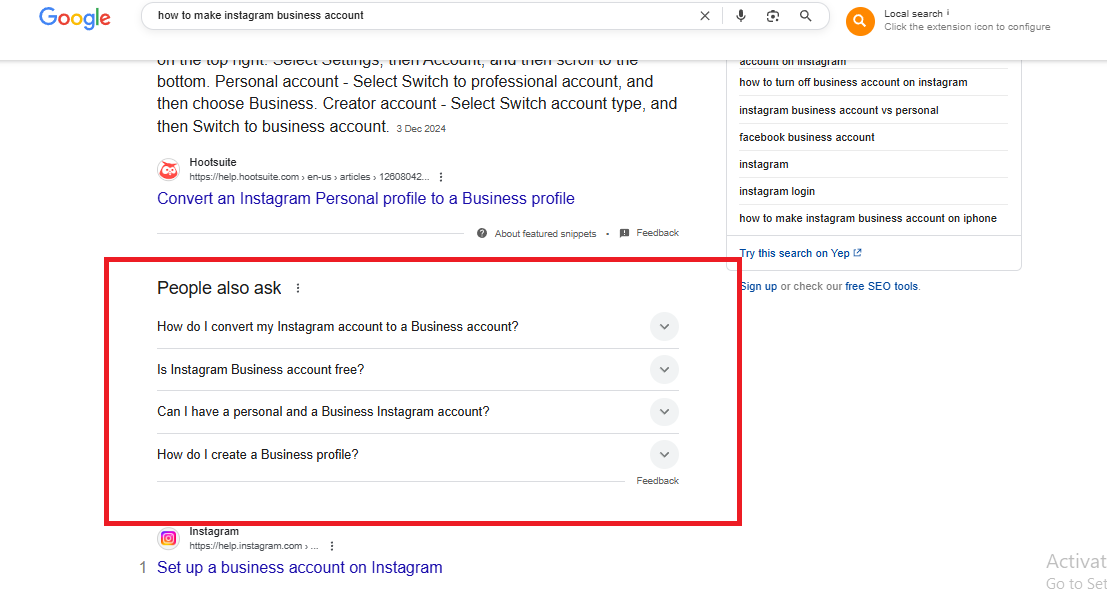
Embedding a video summary, adding a downloadable checklist, or including an expert quote box can enrich the content and appeal to different learning styles. For example, if your blog is about “How to make instagram business account,” try embedding a short video demo using a planning tool like Buffer or Hootsuite.
This improves user experience and makes your content eligible for more search features like rich results and video previews.
Adding videos related to content is also very much important, you can have a look over below.

Recommended Reading
Google’s New Update: Performance Data by the Hour
Google now provides hourly data on how pages perform. Use this to:
- Schedule posts during peak activity
- Identify content that performs better in specific timeframes
- Experiment with dayparting in content campaigns
Google’s March 2025 Core Update: What You Need To Know
This update emphasized:
- Topical authority
- Better contextual linking
- Content depth over keyword repetition
Pages that went deep and answered complex queries holistically saw ranking boosts.
A timeline visual showing the evolution of Google algorithm updates from 2020 to 2025.

Conclusion
Search engine positioning in 2025 is not a hack—it’s a methodical pursuit of digital dominance. You’re no longer just creating content for its own sake. You’re curating, optimizing, linking, and evolving.
To outpace the competition:
- Track your SERP position monthly
- Update content biannually or sooner
- Link smartly from within
- Test new formats
It’s not about gaming the algorithm; it’s about becoming worthy of the top spot.
(FAQS)
❓ What’s the difference between search engine positioning and SEO?
SEO is broad and involves all activities to improve visibility. Positioning focuses on where your page ranks for specific queries—and how to move it higher.
❓ How long does it take to improve search engine positioning?
Changes can reflect in 1–6 weeks, depending on your domain strength and the intensity of your efforts.
❓ Does internal linking help boost rankings?
Yes. It improves crawlability, authority flow, and user engagement.
Think of it as signs in a library that guide readers to other books they might enjoy.
❓ Should I update old content or create new content?
Both. Update old content to maintain relevance. Create new content to capture emerging queries.
❓ What tools can help track search engine positioning?
Use:
- SEMrush
- Ahrefs
- Google Search Console
- Serpstat
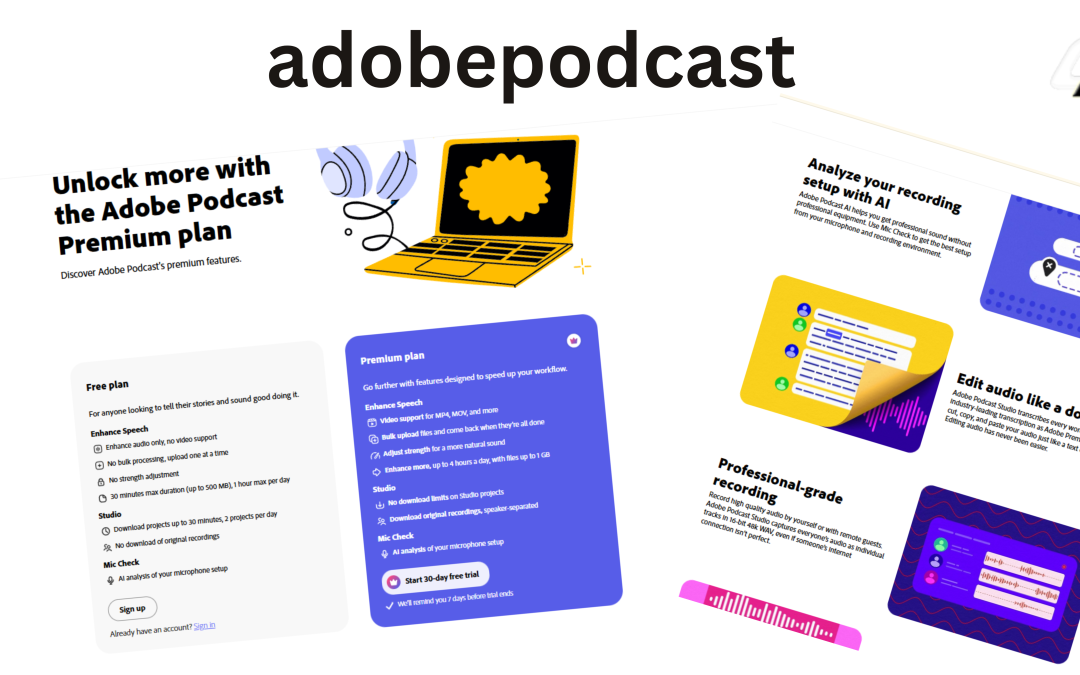
by Shashikanth Heerekar | Nov 13, 2024 | Uncategorized
Discover how Adobe Podcast can revolutionize your podcasting workflow. Learn about its powerful features, from AI-powered audio enhancement to remote recording and transcription.
Introduction
In the rapidly growing world of podcasts, high-quality audio and efficient editing are essential to keep audiences engaged. Adobe Podcast, Adobe’s dedicated podcast editing software, revolutionizes the podcasting experience with AI-powered tools catering to beginners and professionals. This article will explore how Adobe Podcast simplifies audio production, making it accessible for creators at all levels.
Key Features of Adobe Podcast
AI-Powered Audio Enhancement
One of the standout features of Adobe Podcast is its AI-powered audio enhancement. This tool automatically cleans up audio by reducing background noise, eliminating echo, and enhancing voice clarity, making it easier to remove background distractions.. AI algorithms identify and remove imperfections, producing a smooth, studio-quality sound that resonates with listeners. With Adobe’s advanced audio editing software, even recordings made in imperfect conditions can sound polished and professional.
Transcription and Editing
Adobe Podcast simplifies editing with automatic transcription, converting spoken audio into text for easy editing and organization. This feature lets podcasters quickly locate, edit, and rearrange specific segments of their recordings without scrubbing through audio files manually. Transcription also helps streamline the podcasting workflow by allowing editors to make textual changes that reflect directly in the audio, making Adobe Podcast one of the best podcast transcription tools available.
Remote Recording
With Adobe Podcast’s remote recording capabilities, in-person recording has become less essential. Podcasters can now record high-quality audio with multiple guests from any location. This feature captures each participant’s audio separately, ensuring clarity and minimizing background noise. Adobe’s remote podcast recording solution is perfect for creators who want to host guests from anywhere in the world without compromising audio quality.
Royalty-Free Music
Music is often a crucial element in creating an immersive podcast experience. Adobe Podcast offers access to a library of royalty-free music specifically curated for podcasts, adding a professional touch to intros, transitions, and outros. With various tracks at their fingertips, podcasters can enhance their shows with music that suits their content’s tone without worrying about copyright issues.
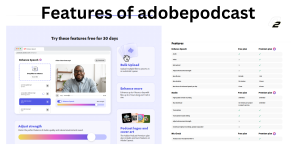
How to Use Adobe Podcast
Step-by-Step Guide
- Recording: Open Adobe Podcast and start a new project. Select either in-person or remote recording options, depending on your setup. If using remote recording, invite your guests to join the session.
- Editing: Once recorded, access the transcription feature to make edits by highlighting text or rearranging sections in the transcript. Adobe’s intuitive interface makes editing a breeze for novice and experienced editors.
- Enhancing Audio: Use AI-powered enhancement tools to remove noise and improve clarity. Any more audio parameters can be changed as needed.
- Adding Music: Browse the royalty-free music library to select tracks that complement your content. Add music to your timeline and adjust volumes to blend smoothly with your voiceover.
- Publishing: Export the final product in your preferred format. Adobe Podcast also allows direct publishing to various podcast platforms.
Tips and Tricks
Use Headphones: To avoid feedback during remote recording sessions.
Organize with Labels: Label key moments during transcription to quickly locate important segments.
Experiment with Music: Try different royalty-free tracks until you find the perfect fit to elevate your podcast’s atmosphere.
Save Regularly: Save your work to prevent data loss and ensure all edits are captured.
Benefits of Using Adobe Podcast
Time-Saving
Adobe Podcast’s tools are designed to streamline the entire podcasting workflow. Adobe’s software reduces manual work from transcription to audio enhancement, allowing creators to focus on content rather than technical details. The time saved can be redirected to refining content, marketing, and engaging with listeners.
Improved Audio Quality
With AI-powered podcasting technology, Adobe Podcast significantly enhances audio quality, even if recorded in less-than-ideal environments. The noise reduction and echo elimination features ensure a professional sound without requiring extensive audio engineering knowledge.
Professional-Grade Results
For creators who want polished results but need more technical skills, Adobe Podcast’s user-friendly interface and AI-driven tools make it easy to produce professional-grade podcasts. This podcast production tool is ideal for users who need reliable audio quality without investing in complex setups or advanced audio editing software.
Adobe Podcast vs. AudioEnhancer.ai: Which Should You Use?
While Adobe Podcast offers an all-in-one solution for recording, editing, and publishing podcasts, some creators may prefer using standalone tools for specific tasks like audio enhancement.
| Feature |
Adobe Podcast |
AudioEnhancer.ai |
| AI Audio Enhancement |
✅ Built-in |
✅ Standalone Tool |
| Audio Editing |
✅ Text-based & timeline |
❌ Not available |
| Remote Recording |
✅ Yes |
❌ No |
| Ease of Use |
⭐⭐⭐⭐ |
⭐⭐⭐⭐⭐ |
| Best For |
All-in-one podcast production |
Quick enhancement of any audio file |
Use Adobe Podcast if you’re managing an entire podcast production from start to finish.
Use AudioEnhancer.ai if you already have recordings and want to enhance them instantly without complex software.
Many creators use both: enhance their audio with Audioenhancer.ai first, then edit and publish using Adobe Podcast.
Additional Elements of abode-podcast
User Interface and Accessibility:
Describe Adobe Podcast’s user-friendly design. Mention any customization options, such as editing layouts or shortcuts, that make navigating and managing projects easier for creators at all levels.
Export and Distribution Options:
Provide details on Adobe Podcast’s export options, such as audio formats and compatibility with major podcast hosting platforms. Discuss whether Adobe offers direct publishing to platforms like Spotify, Apple Podcasts, etc.
Community and Support Resources:
Highlight Adobe’s support resources, such as tutorials, forums, and customer support channels. This will appeal to new users who may need extra guidance.
Comparative Analysis with Other Software:
Comparing Adobe Podcast with other popular podcast editing software can illustrate its unique features, helping readers understand its competitive edge.
User Testimonials or Case Studies:
Adding real-life user examples or testimonials can make the benefits more relatable and demonstrate Adobe Podcast’s impact in real-world settings.
Pricing Information:
If Adobe Podcast is subscription-based, offer a quick pricing or trial options overview. This helps readers make informed decisions about adopting the software.
Adding these elements would give readers a thorough understanding of Adobe Podcast’s features and benefits, making the article more valuable and actionable. Let me know if you’d like more suggestions on these points!
Conclusion
Adobe Podcast combines advanced features like AI-powered audio enhancement, transcription, and remote recording to provide an all-in-one solution for podcast production. With its intuitive interface and royalty-free music library, Adobe Podcast allows users to produce high-quality audio with minimal effort, making it an essential tool for podcasters of all levels.
Try Adobe Podcast today to experience how it can transform your podcasting journey with seamless recording, editing, and publishing features. Whether you’re a seasoned creator or a newcomer to podcasting, Adobe Podcast offers tools to help you create content that truly resonates.

by Shashikanth Heerekar | Nov 12, 2024 | All Things about Marketing, Uncategorized
Explore Global Trade Review (GTR) to stay updated on the latest news, insights, and trends in trade finance. Learn about market dynamics, regulatory changes, and expert analysis to help navigate global trade successfully.
Introduction
Global Trade Review (GTR) has become a cornerstone resource for professionals in the trade finance industry. With the ever-evolving dynamics of global trade, GTR plays a crucial role in delivering timely insights, analysis, and resources on international trade, trade finance, and related topics. From covering the latest updates in global trade to hosting industry-leading events, GTR supports companies and stakeholders in navigating the complexities of the trade world. This article delves into GTR’s role, recent updates, awards, and other contributions to the trade finance industry.
The Role of Global Trade Review (GTR) in Trade Finance
GTR provides an indispensable platform for sharing knowledge, analysis, and news across various trade finance topics, including global trade, international trade, export and import finance, supply chain finance, and trade credit insurance. By gathering insights from industry experts and thought leaders, GTR helps businesses make informed decisions in a landscape impacted by geopolitical risks, economic sanctions, and advances in digital trade.
Key Areas Covered by GTR:
- Trade Finance News and Trends – Cover market trends, regulatory updates, and industry innovations.
- Supply Chain Finance – Insights on securing supply chain financing and addressing liquidity challenges.
- Geopolitical and Economic Analysis – Updates on global economic policies, sanctions, and trade barriers.
- Sustainable Trade – Analysis of ESG (environmental, social, and governance) principles shaping sustainable trade practices.
- Digitalization in Trade – Exploring blockchain, digital documents, and technology solutions for a modern trade finance infrastructure.
GTR delivers content that supports businesses in meeting challenges and strengthens the trade finance community by fostering dialogue and collaboration among its members.
Latest Topics and Updates on GTR
1. Digital Trade Transformation
GTR has prominently focused on the digitalization of trade in recent years. Advancements in blockchain and digital documentation are shaping the future of digital trade by enhancing efficiency and reducing fraud. GTR has reported extensively on digital trade initiatives, covering technologies that enable real-time tracking, secure payments, and faster transaction processing.
2. Sustainable and Responsible Trade
The demand for sustainable trade has gained momentum, and GTR plays a critical role in promoting these conversations. With ESG becoming a priority for businesses globally, GTR shares insights on sustainable trade practices, such as green financing and environmentally friendly logistics, that contribute to a positive global impact. Emerging regulations like the EUDR are also shaping sustainable trade by requiring greater transparency and due diligence in sourcing practices, particularly in sectors linked to agriculture and forestry.
3. Addressing Geopolitical and Economic Risks
GTR provides an in-depth analysis of geopolitical risks and economic sanctions that impact global trade. For example, the publication closely follows economic sanctions affecting trade with Russia, China, and other nations. These insights help companies develop strategies for mitigating risks associated with international transactions and trade agreements.
4. Trade Finance in a Post-Pandemic Economy
The COVID-19 pandemic reshaped global trade, creating supply chain disruptions and accelerating the need for digital transformation. GTR has explored how companies are recovering from these impacts and adapting their trade finance practices to a post-pandemic world, highlighting trends in remote working, online payment systems, and risk management strategies.
Global Trade Review Awards and Recognition
The Global Trade Review Awards celebrate excellence and innovation in the trade finance industry. They are among the most respected recognitions, honouring companies, banks, and individuals who have demonstrated outstanding achievements in trade finance.
Highlights of GTR Awards:
- Categories: Awards cover various categories, including trade finance, export finance, supply chain finance, and sustainable trade.
- Eligibility: Companies and individuals are nominated based on their innovative solutions, global trade impact, and industry advancement contributions.
- Recent Award Winners (2023): Winners of the GTR Awards for 2023 include banks and financial institutions that have introduced novel trade finance solutions, supported sustainable trade, and demonstrated leadership in challenging market environments.
Global Trade Review Events and Conferences
GTR is known for hosting high-profile events and conferences worldwide, attracting industry professionals, policymakers, and corporate leaders to discuss the future of trade finance. 
Notable GTR Events:
- GTR Asia, GTR Europe, GTR Africa, and GTR MENA are regional events that allow professionals to network, discuss local trade finance challenges, and share global solutions.
- GTR Conference Highlights: These conferences address regulatory updates, economic sanctions, sustainable trade finance, and digital transformation.
- Networking and Learning Opportunities: Attendees benefit from engaging panels, expert talks, and networking sessions that foster collaboration across the trade finance community.
Global Trade Review (GTR) Milestones and Historical Impact
Since its establishment, GTR has achieved several milestones, contributing to the evolution of trade finance through its publications and events. A look at GTR’s key achievements highlights its role in shaping the industry:
- Global Trade Review 2019-2022: GTR’s publications from 2019 to 2022 documented critical changes in trade finance, particularly the shift toward digital transformation and the impacts of global economic policies on trade.
- Global Trade Review 2023: This year’s reviews have focused on the ongoing digital revolution, the importance of sustainable finance, and navigating new geopolitical landscapes.
- Elite Global Trade Review and Global Trade Options Review: Through its “elite” content and special reports, GTR provides in-depth analyses of significant market shifts, offering tailored advice and expertise to decision-makers in trade finance.
AI’s Impact on Global Trade Review (GTR)
GTR has integrated AI-driven analytics and insights into its platform to provide more actionable content for trade finance professionals. By leveraging AI, GTR can offer:
- Real-Time News and Insights: AI can help GTR analyze large data sets to deliver news on economic sanctions, trade policies, and market trends faster than ever, making content more relevant and timely.
- Customized Content Recommendations: AI-powered recommendation engines suggest articles and insights based on users’ preferences, improving user engagement and ensuring readers find the most relevant information.
- Market and Risk Analysis Tools: GTR’s use of AI has enabled it to create tools that help users assess global trade risks, aiding businesses in making data-driven decisions when entering new markets or managing geopolitical risks.
- Enhanced Networking at Events: AI-driven networking tools at GTR conferences allow attendees to connect with relevant industry peers based on shared interests, resulting in more effective partnerships.
Statistics on AI in Trade Finance
- Automation Efficiency: AI can reduce trade finance document processing time by up to 90%, significantly lowering costs and reducing manual workloads.
- Fraud Detection: AI has helped reduce fraud-related losses by 40% for trade finance firms, safeguarding transactions and improving security.
- Increased Approval Rates: AI in decision-making has increased trade finance application approval rates by 25%, enhancing loan issuance efficiency.
- Improved ESG Compliance: AI-based ESG tools improve reporting accuracy by 40%, helping companies comply with sustainability regulations and attract investment.
How GTR Supports the Trade Finance Industry
1. Providing Expertise and Guidance
GTR’s platform brings together industry experts who contribute their knowledge on topics ranging from trade credit insurance to import and export finance. GTR enables businesses to anticipate market changes and leverage trade finance strategies effectively by featuring thought leadership articles.
2. Shaping Policy through Advocacy
Through its events and publications, GTR also serves as a voice for the trade finance industry, advocating for policies that promote fair and accessible trade. The publication has been instrumental in shedding light on issues that affect the industry, such as economic sanctions and supply chain financing.
3. Offering Education and Training
GTR’s educational content, case studies, and event workshops allow professionals to stay updated on industry best practices, helping them achieve certifications and improve their expertise in partner management strategy and agency partner onboarding.
Impact of Economic and Geopolitical Risks on Global Trade
Geopolitical factors heavily influence global trade, and GTR covers the effects of economic sanctions, trade wars, and regional instabilities on international trade. This information is crucial for businesses seeking to understand the risks of expanding their operations globally and to adapt their trade finance strategies accordingly.
Examples of Key Issues Covered:
- Sanctions and Trade Restrictions – Analyzing the impact of sanctions on trade with countries like Russia and China.
- Supply Chain Vulnerabilities – Reporting on the supply chain disruptions due to geopolitical tensions and economic uncertainties.
Digital Trade Transformation and the Future of Trade Finance
Digitalization has revolutionized the trade finance industry, with GTR at the forefront of reporting on these advancements. Key digital trends include blockchain, e-invoicing, and AI-based credit risk assessment, which streamline processes and increase transparency.
Digital Trade Topics Covered by GTR:
- Blockchain Applications in Trade – How blockchain secures transactions and reduces fraud.
- AI and Predictive Analytics – How AI is used for predictive risk management in trade finance.
- E-Documentation and Paperless Trade – The shift toward paperless trade through digital documents and e-signatures.
Conclusion
Global Trade Review (GTR) is a trusted source for trade finance professionals. It provides invaluable insights into global trade dynamics, digital transformation, and sustainable finance practices. GTR has become a vital resource for navigating the complex world of trade finance by connecting trade finance experts and fostering dialogue on economic challenges and innovations. Through its comprehensive news coverage, industry events, and prestigious GTR Awards, GTR continues to set the standard for excellence in global trade finance, enabling professionals to make informed decisions in an ever-evolving market.
by Shashikanth Heerekar | Nov 2, 2024 | Uncategorized
Introduction to Ethernet Junction Boxes
Ethernet junction boxes are essential components in modern wired networking systems that join, extend, and manage Ethernet cables. Whether installing a home network or managing a large commercial or industrial network, junction boxes help simplify cable management, protect connections, and ensure reliable data transmission.
Maintaining the integrity of wired networks is crucial in today’s fast-paced world, where businesses rely on stable, high-speed internet connections. Ethernet junction boxes play a vital role in this process by ensuring that Ethernet cables remain securely connected and free from damage. This article will explore the various types of Ethernet junction boxes, their importance, how to choose the right one, installation tips, maintenance practices, and troubleshooting advice.
The Importance of Using Ethernet Junction Boxes in Network Installations
Ethernet junction boxes are more than just cable organizers. They are critical for ensuring the reliability and performance of wired networks. Without proper cable management, networks can experience various problems, from slow data speeds to total disconnections. Junction boxes provide a centralized location for connecting multiple Ethernet cables, reducing the risk of damage and ensuring a cleaner, more organized installation.
Poor cable connections can result in significant issues such as signal interference, data loss, and network downtime. A well-placed Ethernet junction box keeps cables connected and protected from external elements like dust, moisture, and physical stress. This is especially important in industrial or outdoor environments where cables are more exposed to harsh conditions.
Key Benefits of Ethernet Junction Boxes:
- Improved Cable Management: By organizing multiple Ethernet cables in one place, junction boxes reduce clutter and make it easier to manage and troubleshoot connections.
- Protection from External Factors: Junction boxes protect cables from environmental factors such as dust, moisture, and physical damage, ensuring long-lasting performance.
- Scalability: As networks grow, adding new cables and connections becomes easier with Ethernet junction boxes, allowing for seamless network expansion.
- Reduced Signal Interference: Shielded junction boxes prevent electromagnetic interference (EMI), which can degrade network performance.
Types and Features of Ethernet Junction Boxes
Several different types of Ethernet junction boxes are designed to meet the needs of various environments. Choosing the right type depends on where the junction box will be installed and the specific requirements of your network. Let’s take a closer look at the main types of Ethernet junction boxes.
Indoor Ethernet Junction Boxes
Indoor Ethernet junction boxes are typically used in the home or office settings where the environment is controlled, and there is no exposure to harsh conditions. These boxes are compact, easy to install, and provide basic protection for Ethernet cable connections. They are ideal for keeping cables organized in server rooms, under desks, or behind walls where space is limited.
Outdoor Ethernet Junction Boxes
Outdoor Ethernet junction boxes are a must for installations that take place outside. These boxes are designed to withstand environmental conditions like rain, snow, dust, and extreme temperatures. Outdoor junction boxes are often used in industrial settings, security camera installations, or outdoor Wi-Fi access points. Many outdoor boxes come with an IP (Ingress Protection) rating, which indicates their ability to resist water and dust. IP66 and IP67 are common ratings for outdoor junction boxes, offering high levels of protection.
Shielded Ethernet Junction Boxes
Shielded Ethernet junction boxes are essential in environments where electromagnetic interference (EMI) is a concern. EMI can disrupt network signals and lead to data loss or slower speeds. Shielded boxes include a conductive material layer that blocks EMI, ensuring smooth data transmission. These junction boxes are commonly used in data centres, manufacturing plants, and areas with a high concentration of electrical equipment.
Key Features to Look for in an Ethernet Junction Box:
- Durability: To ensure long-term durability, look for junction boxes made from high-quality materials such as ABS plastic or metal.
- Compatibility: Make sure the box is compatible with your network cables, whether Cat5, Cat6, Cat6a, or Cat7. Different Ethernet standards have different speeds and capabilities, so matching the box to your cable type is important.
- Weatherproofing: If installing the junction box outdoors, ensure it has proper weatherproofing, such as a rubber gasket seal to prevent water ingress.
- Mounting Options: Consider junction boxes that offer flexible mounting options, such as wall or pole mounts, depending on your installation needs.
Factors to Consider When Choosing an Ethernet Junction Box
Selecting the right Ethernet junction box for your network installation requires careful consideration. The right junction box can result in better network performance or cable damage. Here are the most important factors to consider when choosing an Ethernet junction box:
1. Location
The location is one of the most important factors in where you plan to install the junction box. A simple plastic box may be sufficient for indoor installations, but a rugged, weatherproof box is necessary for outdoor or industrial installations. If you’re placing the junction box in an area prone to electrical interference, consider a shielded box to protect the network from EMI.
2. Cable Compatibility
Different types of Ethernet cables (e.g., Cat5, Cat6, Cat7) have varying speed, distance, and signal strength capabilities. Ensure the junction box is compatible with the type of Ethernet cables you are using. If your high-speed network carries large data, you may need a box designed to handle Cat6 or Cat7 cables.
3. Number of Connections
The size of your network and the number of cables you need to connect will determine the size and type of junction box you need. Some boxes can handle multiple connections, while others are designed for just one or two. Avoid overcrowding the box, as this can lead to signal degradation or physical damage to the cables.
4. Future Expansion
When selecting a junction box, consider the possibility of future network expansion. A box accommodating additional connections may save time and money if your network grows.
5. Ease of Installation
Look for junction boxes that are easy to install, with clear instructions and accessible cable entry points. Some junction boxes come pre-assembled with built-in connectors, while others require more hands-on installation.
Installation and Best Practices for Using Ethernet Junction Boxes
Installing an Ethernet junction box is relatively straightforward, but following best practices will help ensure a successful and durable installation. Below is a step-by-step guide to installing an Ethernet junction box:
Step-by-Step Installation Guide:
- Select the Installation Location: Choose a location that is easily accessible for future maintenance and where cables can be routed efficiently.
- Prepare the Ethernet Cables: Strip the cables to expose the wires inside.
- Connect the Wires: Inside the junction box, connect the corresponding wires using the terminal blocks or connectors provided. To ensure correct connections, follow the T568A or T568B wiring standards for Ethernet cables.
- Secure the Box: Mount the junction box to the wall, ceiling, or other surfaces using screws or brackets. Ensure the box is securely attached to prevent any cable movement or damage.
- Test the Connection: Use a network tester to check that the data is transmitted correctly once the wires are connected. This will help you identify wiring mistakes or signal issues before finalizing instafinalized
Best Practices for Installing Ethernet Junction Boxes:
- Label the Cables: Label each Ethernet cable to identify its purpose or destination. This will make troubleshooting easier if network issues arise in the future.
- Leave Room for Expansion: Don’t overcrowd the junction box. Leave some space for future connections, especially if your network is likely to expand.
- Avoid Sharp Bends: Ethernet cables are sensitive to sharp bends or kinks, which can affect signal quality. Ensure that cables are routed smoothly into the box.
Maintenance and Troubleshooting Tips for Ethernet Junction Boxes
Proper maintenance is essential for ensuring long-term network reliability. While Ethernet junction boxes don’t require much maintenance, regular inspections can help avoid costly repairs or network downtime.
Maintenance Tips:
- Inspect Cables and Connections: Periodically check the cables inside the junction box for wear and tear. Loose connections can lead to data transmission issues, so all connections remain tight.
- Clean the Box: Dust and dirt can accumulate inside the junction box, especially in outdoor or industrial settings. Cleaning the box regularly can prevent issues related to overheating or moisture buildup.
- Check for Corrosion: If you’re using an outdoor junction box, moisture can cause corrosion over time. Inspect the box for rust or damage signs and replace corroded parts to prevent signal degradation.
Troubleshooting Common Issues:
- Loose Connections: If you experience network slowdowns or interruptions, check the connections inside the junction box to ensure they are secure. Loose wires are a common cause of network issues.
- Signal Interference: If you’re experiencing inconsistent data speeds, electromagnetic interference could be the culprit. Switch to a shielded junction box or relocate the box away from potential sources of EMI, such as power lines or heavy machinery.
- Water Damage: Water ingress can be a serious issue for outdoor installations. If water has entered the junction box, disconnect the cables and dry the box thoroughly before resealing it.
FAQ’s
Q1. What is an Ethernet junction box, and why is it used?
A: An Ethernet junction box connects and extends Ethernet cables, providing secure and organizeable management. It’s used in network installations to ensure stable data transmission and protect cables from damage.
Q2. How do I choose the right Ethernet junction box?
A: To choose the right junction box, consider the installation environment (indoor or outdoor), cable type (e.g., Cat5, Cat6), and whether you need protection from electromagnetic interference (EMI). Ensure the box can accommodate your network’s size and future expansion.
Q3. Can an Ethernet junction box improve network reliability?
A: Yes, by organizing and protecting cable connections, Ethernet junction boxes improve network reliability, reduce signal interference, and minimize physical damage. They ensure smooth data transmission and simplify future maintenance or expansions.
Q4. How often should I maintain an Ethernet junction box?
A: Regular inspections every 6–12 months are recommended. Check for loose connections, clean dust or debris, and inspect for signs of corrosion, especially in outdoor installations. Routine maintenance ensures long-term network stability.
Conclusion
Ethernet junction boxes are indispensable for creating scalable and reliable wired networks. They help protect and manage Ethernet connections in home setups, offices, or industrial installations. Choosing the right junction box for your needs, following proper installation procedures, and performing regular maintenance will ensure your network remains efficient and trouble-free for years.

















